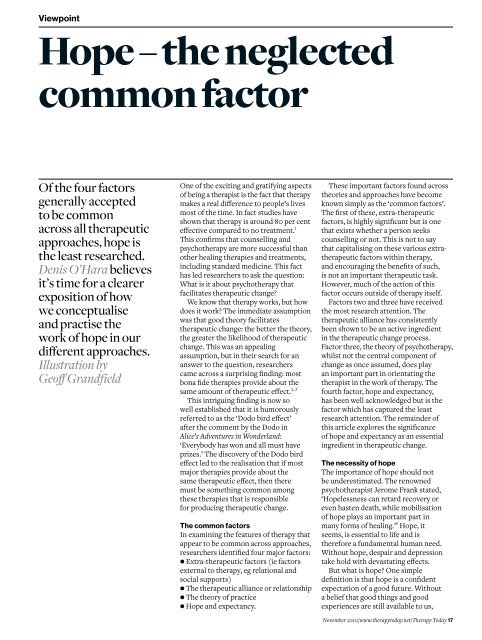Therapy Today
15301_november%202010
15301_november%202010
You also want an ePaper? Increase the reach of your titles
YUMPU automatically turns print PDFs into web optimized ePapers that Google loves.
Viewpoint<br />
Hope – the neglected<br />
common factor<br />
Of the four factors<br />
generally accepted<br />
to be common<br />
across all therapeutic<br />
approaches, hope is<br />
the least researched.<br />
Denis O’Hara believes<br />
it’s time for a clearer<br />
exposition of how<br />
we conceptualise<br />
and practise the<br />
work of hope in our<br />
different approaches.<br />
Illustration by<br />
Geo Grandfield<br />
One of the exciting and gratifying aspects<br />
of being a therapist is the fact that therapy<br />
makes a real difference to people’s lives<br />
most of the time. In fact studies have<br />
shown that therapy is around 80 per cent<br />
effective compared to no treatment. 1<br />
This confirms that counselling and<br />
psychotherapy are more successful than<br />
other healing therapies and treatments,<br />
including standard medicine. This fact<br />
has led researchers to ask the question:<br />
What is it about psychotherapy that<br />
facilitates therapeutic change?<br />
We know that therapy works, but how<br />
does it work? The immediate assumption<br />
was that good theory facilitates<br />
therapeutic change: the better the theory,<br />
the greater the likelihood of therapeutic<br />
change. This was an appealing<br />
assumption, but in their search for an<br />
answer to the question, researchers<br />
came across a surprising finding: most<br />
bona fide therapies provide about the<br />
same amount of therapeutic effect. 2, 3<br />
This intriguing finding is now so<br />
well established that it is humorously<br />
referred to as the ‘Dodo bird effect’<br />
after the comment by the Dodo in<br />
Alice’s Adventures in Wonderland:<br />
‘Everybody has won and all must have<br />
prizes.’ The discovery of the Dodo bird<br />
effect led to the realisation that if most<br />
major therapies provide about the<br />
same therapeutic effect, then there<br />
must be something common among<br />
these therapies that is responsible<br />
for producing therapeutic change.<br />
The common factors<br />
In examining the features of therapy that<br />
appear to be common across approaches,<br />
researchers identified four major factors:<br />
••<br />
Extra-therapeutic factors (ie factors<br />
external to therapy, eg relational and<br />
social supports)<br />
••<br />
The therapeutic alliance or relationship<br />
••<br />
The theory of practice<br />
••<br />
Hope and expectancy.<br />
These important factors found across<br />
theories and approaches have become<br />
known simply as the ‘common factors’.<br />
The first of these, extra-therapeutic<br />
factors, is highly significant but is one<br />
that exists whether a person seeks<br />
counselling or not. This is not to say<br />
that capitalising on these various extratherapeutic<br />
factors within therapy,<br />
and encouraging the benefits of such,<br />
is not an important therapeutic task.<br />
However, much of the action of this<br />
factor occurs outside of therapy itself.<br />
Factors two and three have received<br />
the most research attention. The<br />
therapeutic alliance has consistently<br />
been shown to be an active ingredient<br />
in the therapeutic change process.<br />
Factor three, the theory of psychotherapy,<br />
whilst not the central component of<br />
change as once assumed, does play<br />
an important part in orientating the<br />
therapist in the work of therapy. The<br />
fourth factor, hope and expectancy,<br />
has been well acknowledged but is the<br />
factor which has captured the least<br />
research attention. The remainder of<br />
this article explores the significance<br />
of hope and expectancy as an essential<br />
ingredient in therapeutic change.<br />
The necessity of hope<br />
The importance of hope should not<br />
be underestimated. The renowned<br />
psychotherapist Jerome Frank stated,<br />
‘Hopelessness can retard recovery or<br />
even hasten death, while mobilisation<br />
of hope plays an important part in<br />
many forms of healing.’ 5 Hope, it<br />
seems, is essential to life and is<br />
therefore a fundamental human need.<br />
Without hope, despair and depression<br />
take hold with devastating effects.<br />
But what is hope? One simple<br />
definition is that hope is a confident<br />
expectation of a good future. Without<br />
a belief that good things and good<br />
experiences are still available to us,<br />
November 2010/www.therapytoday.net/<strong>Therapy</strong> <strong>Today</strong> 17


